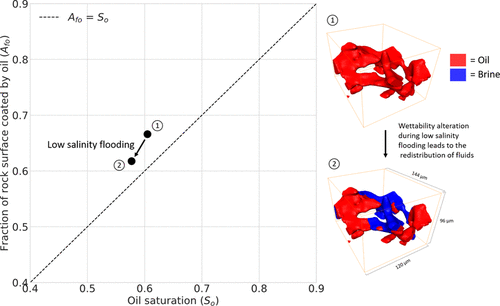当前位置:
X-MOL 学术
›
Energy Fuels
›
论文详情
Our official English website, www.x-mol.net, welcomes your feedback! (Note: you will need to create a separate account there.)
Pore-Scale X-ray Imaging of Wetting Alteration and Oil Redistribution during Low-Salinity Flooding of Berea Sandstone
Energy & Fuels ( IF 5.3 ) Pub Date : 2021-01-05 , DOI: 10.1021/acs.energyfuels.0c03299 Edward Andrews 1 , Ann Muggeridge 1 , Gaetano Garfi 1 , Alistair Jones 1 , Samuel Krevor 1
Energy & Fuels ( IF 5.3 ) Pub Date : 2021-01-05 , DOI: 10.1021/acs.energyfuels.0c03299 Edward Andrews 1 , Ann Muggeridge 1 , Gaetano Garfi 1 , Alistair Jones 1 , Samuel Krevor 1
Affiliation

|
Observations over a range of scales show that lowering the salinity of injected water can alter the wetting state of a rock, making it more water-wet. However, there remains a poor understanding of how this alteration affects the distribution of fluids over the pore and pore-network scale and how this wetting alteration leads to oil recovery. In this work, we observe how oil and brine redistribute in the pores of rocks in response to low-salinity flooding. We use X-ray μ-CT scanning to image tertiary low-salinity waterflooding in two Berea sandstone cores. The wetting state of one core is altered with exposure to crude oil. We characterize the wetting state of both samples using imagery of fluid–solid fractional wetting and pore occupancy analysis. In the unaltered rock, oil saturation, fractional mineral area covered by oil, and size distribution of oil-filled pores remain constant between high-salinity flooding and subsequent low-salinity floods. In contrast, in the altered sample, we observe a shift in the mineral area covered by oil after low-salinity flooding toward decreasing coverage, consistent with a change to a less oil-wetting state. This change is also reflected in the observed variation in fluid pore occupancy. The wetting alteration results in the redistribution of 22% of oil within the rock, but an additional recovery of just three percentage points. The success of low-salinity waterflooding depends on both a wetting alteration and a pore structure, which facilitates the production of mobilized oil.
中文翻译:

Berea砂岩低盐度驱替过程中润湿变化和油分布的孔隙度X射线成像
在一定范围内进行的观察表明,降低注入水的盐度会改变岩石的润湿状态,使其更湿润。但是,对于这种变化如何影响流体在孔隙和孔隙网络规模上的分布以及这种润湿变化如何导致采油的认识仍然缺乏了解。在这项工作中,我们观察到油和盐水如何响应低盐度洪水在岩石孔隙中重新分布。我们使用X射线μ-CT扫描成像两个Berea砂岩岩心中的低盐度三次水驱。暴露于原油会改变一个核的润湿状态。我们使用流体-固体分数润湿和孔占有率分析的图像来表征两个样品的润湿状态。在未改变的岩石中,含油饱和度,被油覆盖的部分矿物区域,在高盐度洪水和随后的低盐度洪水之间,充油孔的尺寸和分布保持恒定。相反,在改变后的样本中,我们观察到低盐度淹没后油所覆盖的矿物质区域向覆盖率降低的方向变化,这与向较少油润湿状态的变化一致。这种变化也反映在观察到的流体孔占有率变化中。润湿改变导致岩石中22%的油重新分布,但仅增加了三个百分点。低盐度注水的成功取决于润湿变化和孔隙结构,这促进了动员油的生产。我们观察到,低盐度淹没后,石油所覆盖的矿产区域向覆盖范围的减小方向转变,这与向较少油润湿的状态的变化一致。这种变化也反映在观察到的流体孔占有率变化中。润湿改变导致岩石中22%的油重新分布,但仅增加了三个百分点。低盐度注水的成功取决于润湿变化和孔隙结构,这有利于生产动员油。我们观察到,低盐度淹没后,石油所覆盖的矿产区域向覆盖范围的减小方向转变,这与向较少油润湿的状态的变化一致。这种变化也反映在观察到的流体孔占有率变化中。润湿改变导致岩石中22%的油重新分布,但仅增加了三个百分点。低盐度注水的成功取决于润湿变化和孔隙结构,这有利于生产动员油。但仅恢复了三个百分点。低盐度注水的成功取决于润湿变化和孔隙结构,这有利于生产动员油。但仅恢复了三个百分点。低盐度注水的成功取决于润湿变化和孔隙结构,这有利于生产动员油。
更新日期:2021-01-21
中文翻译:

Berea砂岩低盐度驱替过程中润湿变化和油分布的孔隙度X射线成像
在一定范围内进行的观察表明,降低注入水的盐度会改变岩石的润湿状态,使其更湿润。但是,对于这种变化如何影响流体在孔隙和孔隙网络规模上的分布以及这种润湿变化如何导致采油的认识仍然缺乏了解。在这项工作中,我们观察到油和盐水如何响应低盐度洪水在岩石孔隙中重新分布。我们使用X射线μ-CT扫描成像两个Berea砂岩岩心中的低盐度三次水驱。暴露于原油会改变一个核的润湿状态。我们使用流体-固体分数润湿和孔占有率分析的图像来表征两个样品的润湿状态。在未改变的岩石中,含油饱和度,被油覆盖的部分矿物区域,在高盐度洪水和随后的低盐度洪水之间,充油孔的尺寸和分布保持恒定。相反,在改变后的样本中,我们观察到低盐度淹没后油所覆盖的矿物质区域向覆盖率降低的方向变化,这与向较少油润湿状态的变化一致。这种变化也反映在观察到的流体孔占有率变化中。润湿改变导致岩石中22%的油重新分布,但仅增加了三个百分点。低盐度注水的成功取决于润湿变化和孔隙结构,这促进了动员油的生产。我们观察到,低盐度淹没后,石油所覆盖的矿产区域向覆盖范围的减小方向转变,这与向较少油润湿的状态的变化一致。这种变化也反映在观察到的流体孔占有率变化中。润湿改变导致岩石中22%的油重新分布,但仅增加了三个百分点。低盐度注水的成功取决于润湿变化和孔隙结构,这有利于生产动员油。我们观察到,低盐度淹没后,石油所覆盖的矿产区域向覆盖范围的减小方向转变,这与向较少油润湿的状态的变化一致。这种变化也反映在观察到的流体孔占有率变化中。润湿改变导致岩石中22%的油重新分布,但仅增加了三个百分点。低盐度注水的成功取决于润湿变化和孔隙结构,这有利于生产动员油。但仅恢复了三个百分点。低盐度注水的成功取决于润湿变化和孔隙结构,这有利于生产动员油。但仅恢复了三个百分点。低盐度注水的成功取决于润湿变化和孔隙结构,这有利于生产动员油。



























 京公网安备 11010802027423号
京公网安备 11010802027423号